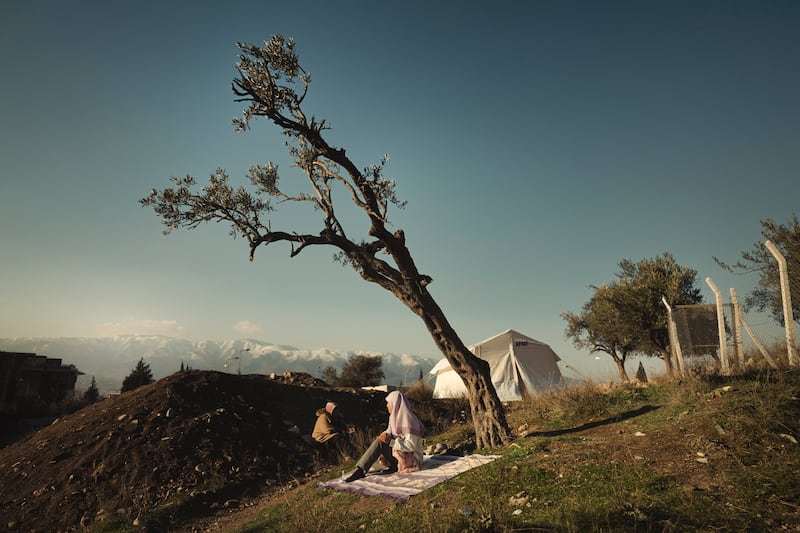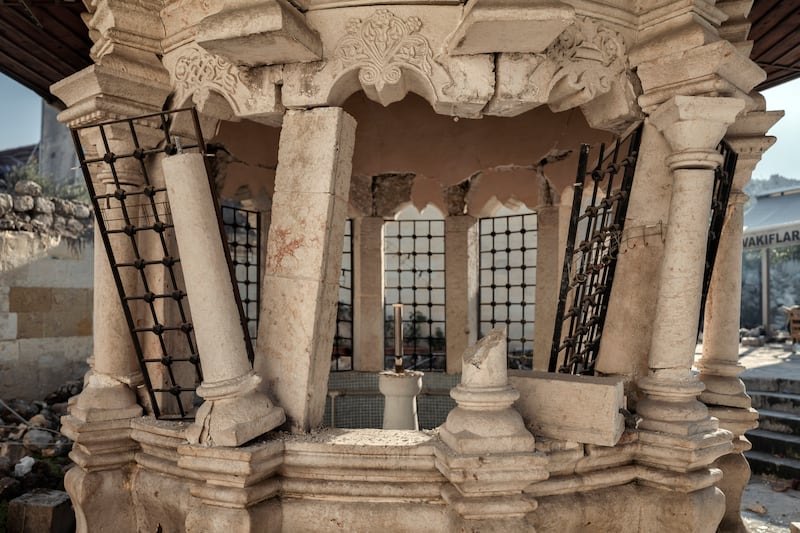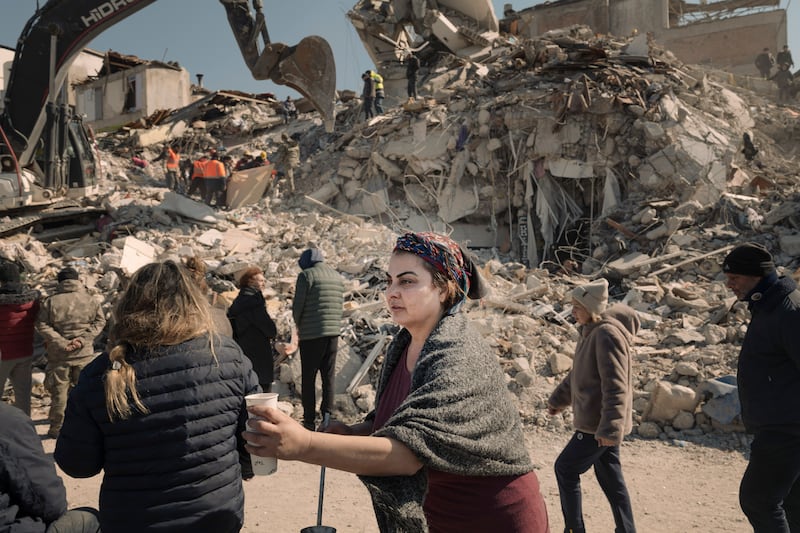They bedded down anywhere they could: on lightless street corners, in grassy little parks, next to an elementary school, on a hillside down from one of the world’s earliest Christian churches.
Across Antakya, the ancient capital of Hatay province, the region hit hardest by the worst earthquake in Turkey in nearly a century, thousands were struggling to make sense of a cataclysm that had turned their lives inside out and left many with no home, possessions, memories and, for some, no future here.
Many were grappling with getting through another night. Cars were cold to sleep in and too small to hold most families. But they could be warmer than tents, which were just a thin layer masking the total devastation of the people inside.
Either was still preferable to a tarp, stretched over a bus shelter or held up by poles. No matter how much wood and trash the Antakyans burned to keep their families warm, it was still freezing cold.
READ MORE
“No electricity, no water, no toilet,” said Saba Yigit (52) a nanny, giving special emphasis to the last item.
Thursday was the third day in a row she had woken up, freezing, in the covered vegetable market where she and her family had taken shelter after Monday’s early morning quake damaged their home near the Mediterranean. “It’s horrible.”

Some of the market’s blue metal stands had been claimed as makeshift beds. Others were still heaped with parsley, cabbage, scallions and cauliflower, now wilting. The ashes of Yigit’s little fire cradled a couple of charred peppers and a carrot, the only cooking her family was able to do in this city of edible marvels, where Mediterranean, Arab and Anatolian cuisines had blended for centuries.
She said the vegetables had come from aid groups — for most people, the only food available in Antakya — not from the bounty around her. Someday, she said, with more wishful thinking than realism, its owners might still want to sell the produce.
On Thursday, as the United Nations’ first aid convoy rolled into opposition-controlled Syria, the death toll in Turkey exceeded the 17,600 mark, making it the deadliest earthquake there in more than 80 years. With the 3,377 fatalities so far in Syria, the number of dead had surpassed 21,000.
Thursday would also be the fourth night most people in the crumpled husk that had been Antakya spent sleeping outside. Many had lost their homes in the earthquake, while others feared the slightest aftershock could send the remaining houses and apartments heaving down, too. They were too scared to go inside to use the few toilets that were working.
“While we wait for tents, we’ll die here in our chairs,” said Sabriye Karaoglan (70), who sat in a blue camp chair on a mountainside promenade overlooking the city, wrapped in a too-thin blanket.
Next to her was a cage of parakeets rescued from her family’s home. In the street in front was the car family members were taking turns sleeping in at night. Once upon a time, they used to drive it to the seaside when it was nice out, she said, taking the same blue chairs along for picnics.

Founded in 300 BC by a former general for Alexander the Great, Antakya has been around long enough to have been destroyed and rebuilt several times. The Greeks, Romans and Byzantines called it Antioch, and it was a trading centre so powerful that it was once the Roman empire’s third-largest city.
The modern city was built atop layers and layers of the ruins of long-gone civilisations. History still pokes through in many places: an early Christian church founded in a cave by Saint Peter and Saint Paul, ancient stone mosques in the oldest part of town, and a stretch of fine Byzantine mosaics uncovered in the construction of a hotel.
But the long view held no comfort for those who got calls every few hours telling them that another loved one had died, a description that applied to most people in Antakya this week. And by Thursday, when they walked the streets, they no longer heard the calls of people trapped under the rubble.
“No more Antakya,” said Kazim Kuseyri (41) the owner of Antakya’s most venerable hotel, the Savon, who was sleeping in a car in the hotel’s courtyard along with about 25 relatives, staff members and their relatives and friends. “I lost my friends. I lost the buildings where I ate and drank with my friends. I lost all my memories. I don’t have any reason to live in Hatay anymore. Because there’s nothing.”

No one was exempted from the disaster. In some neighbourhoods, every building was cracked or in ruins. Even the trees bore scars: people were cutting their branches to burn.
The oldest part of the city, where ancient mosques, churches, Alawite chapels and a synagogue all stood within a few blocks of one another, was almost entirely destroyed. Its existence had been a testament, residents said, to Antakya’s many coexisting religions, though for decades in the past century, sectarian violence often plagued the city, and most Jews had long since left.
A city of more than 200,000, Antakya has also had its tolerance tested over the past decade with the arrival of thousands of Syrian refugees.
Along Independence Road, the world’s first lighted street, shoppers, strollers and tourists had bustled in and out of a kebab restaurant, a spice store, a sweets shop, a tailor, a pharmacy, a hairdresser and more, all now cracked or destroyed.
“It hurts to see Independence Road like this,” said Ahmet Gunes (34) a Turkish Kurd who often came to Antakya from his town, Sanliurfa, to sell livestock. “It’s a perfect place. I wish this had happened to my hometown instead.”
New satellite images from today, February 8, of areas in #Antakya, #Turkey that have been heavily affected by the recent #earthquake. Damage can be seen throughout the area, particularly with numerous high-rise apartments buildings that have collapsed. pic.twitter.com/zhK9WnJYtS
— Maxar Technologies (@Maxar) February 8, 2023
Across the street from the elegant Ottoman-era Liwan Hotel, three body bags lay on the sidewalk. The labels said one held a 19-year-old Syrian, and another a 10-year-old Turk.
A Syrian man in socks and sandals stumbled up, clutching a list of six names written on a torn piece of cardboard. They were relatives of his, among them his parents.
They had all died, he said. He staggered off, covering his face.
Along with a friend, Isa Solmaz (51) who grew up in the neighbourhood before moving to Istanbul for work, was guarding an artist’s shop against looters. His brother had saved their mother from the rubble of her home, but everything else they had known as children — everything else their parents, and their parents’ parents before them, had been proud of — was gone.
The smell of a savoury flatbread coming out of the oven in the bakery down the street used to send them running downstairs to buy a helping. An older neighbour who has since died used to take them in when they ran away from their mother’s scoldings.
“You sleep, you wake up, and then you don’t remember your childhood anymore,” Solmaz said, predicting that most Antakyans would leave the city. “It’s a loss of memory. It’s not a city that’s gone here. It’s an entire history; it’s a civilisation.”

All night, the sounds of calamity broke the sleep of the displaced. Sirens wailed non-stop. Every few minutes, helicopters carrying aid could be heard overhead.
With shops, kitchens and restaurants closed or destroyed, the only food came in the form of humanitarian aid, often lentils with plain pasta, canned tuna or biscuits from a package.
Another problem was keeping in touch with relatives and friends without much electricity or mobile service. Power outlets had disappeared along with homes and offices, and dozens of people huddled around the few mobile electricity vans, plugging their cellphones into the power strips that snaked out in every direction.
🇹🇷 Antakya, Turkey looks like a war zone pic.twitter.com/XhRivKnjCP
— 𝚁𝙰𝙶𝙴 𝙰𝙶𝙰𝙸𝙽𝚂𝚃 𝚃𝙷𝙴 𝚅𝙰𝙲𝙲𝙸𝙽𝙴 (@72powpow) February 10, 2023
Relying on cars for power was tricky, as fuel is scarce in Hatay province, and the amount of gas people are allowed to buy is limited.
Most of all, everyone was cold.
Although aid groups had distributed some blankets and warm clothing, people sleeping in the open had to burn anything they could find to warm up. Mobile vans and volunteers offered hot tea and lentil soup in some places, and the sun brought some relief to freezing fingers. But when night fell, the struggle for warmth began again.
A few days ago, Antakyans would not have believed they could live like this or that they would ever call another place home. A few days in, they found themselves planning to leave.
“Hatay is over,” said Ibrahim Kaya (55) who was also sheltering in the vegetable market with relatives.
All they had managed to save from their home was a bag of borek, a kind of cheese pastry. When a visitor arrived, however, living on charity did not prevent them from offering hospitality. They poured tea and offered the pastry; they smiled, briefly, through tears. — This article originally appeared in The New York Times.
2023 The New York Times Company










